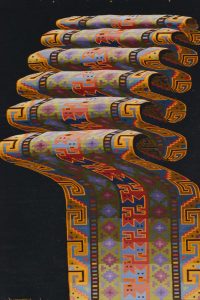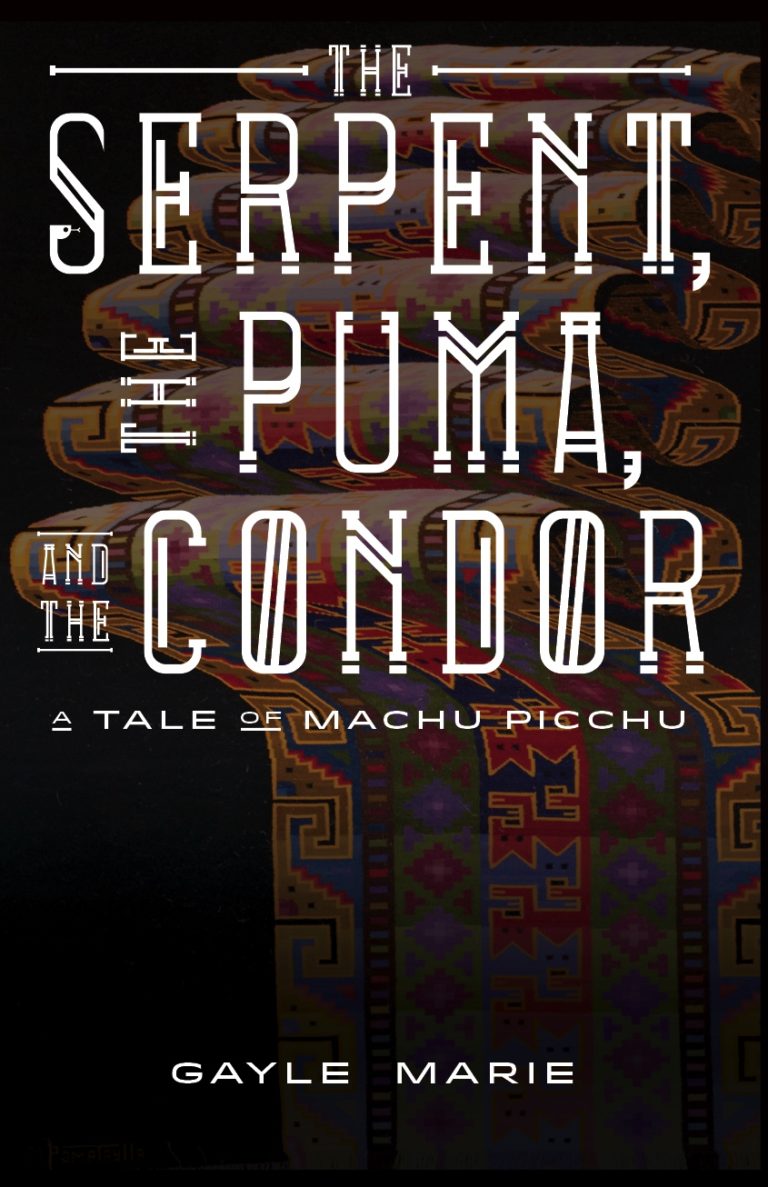Backstory
What follows are journal entries and photos from my second trip to Peru, a journey that made it possible for me to write The Serpent, The Puma, and The Condor: A Tale of Machu Picchu.
THE BIRTH OF A NOVEL
APRIL – MAY, 2015
DAY ONE began in gloomy Lima at the Aeropuerto Internacional Jorge Chavez. It’s always gloomy in Lima for good reason. Francisco Pizarro founded the city after practically decimating the Incas, and Lima is now being punished by Inti, the Sun God. So, no sunshine in Lima – EVER!
Washi (Washington Gibaja Tapia), my guide from my first trip to Peru two years ago, and now my friend, my “Brother From the South”, met me at the airport in Cusco, and after picking up Eduardo Chura Apaza, a Qeros healer, we drove through the Sacred Valley. This place feels almost too green, too fertile. The terraces for planting run all the way up the mountains and into the clouds. How on earth do they harvest?
Even before settling into my room, I was treated with a cleansing ceremony on the banks of the Urumbamba River, the Sacred River that snakes around Machu Picchu. Eduardo, my personal shaman for the next three days — let me repeat that — my personal shaman for the next three days! — blew smoke into the top of my head (seriously!), blessed as many of my chakras as prudence would allow, and spritzed me with Agua de Florida, made from amber and Benzoin (which I learned is an aromatic concoction made from the bark of trees and is magically refreshing for mind, body and spirit). Eduardo pulled me close for the ceremony, and his personal scent blew my mind – his alpaca tunic, whatever he’d had for lunch, and a musky undertone of earth and sun — not unpleasant but very foreign. 
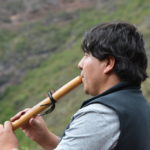 Washi burned sage and played the flute, and together, he and Eduardo chanted in the language of the ancient Incas as they blessed me and strengthened me for my journey. While my mind remained resistant to the idea of blessings and prayer, my sensitivities were not immune to the ceremony, and I was suddenly attacked by my own tears. Eduardo was very pleased and took credit for opening my heart.
Washi burned sage and played the flute, and together, he and Eduardo chanted in the language of the ancient Incas as they blessed me and strengthened me for my journey. While my mind remained resistant to the idea of blessings and prayer, my sensitivities were not immune to the ceremony, and I was suddenly attacked by my own tears. Eduardo was very pleased and took credit for opening my heart.
Now, I’m sitting down to a dinner of grilled veggies in the lovely hotel dining room. Imagine eating vegetables grown in a place called “The Sacred Valley”. The zucchini squeaks as I bite into it; the onions and carrots are sweet in totally different ways; the kernels of corn are as big as my thumbnail; the potatoes actually taste like potatoes, having just been dug from Pacha Mama, Mother Earth. This food makes me want to live underground so I can graze on things that haven’t yet been harvested, eating it while it still breathes.
DAY TWO began with a hike up into the mountains behind my hotel, and ended with a funeral. How’s that for an opening line?
This morning, I dressed for the hike, putting on my running tights, a hot pink shirt, and my brand-new peacock blue running shoes. (These details will become more relevant later on.) As Washi, Eduardo, and I climbed, and as I tried to NOT run out of oxygen (9,800 feet elevation at the river!), I realized that by asking a question about shamanism, several minutes of discussion and translations between Washi and Eduardo could almost certainly give me time to catch my breath before I had to speak again. I, of course, followed up immediately with another question. We continued on this way until we came to a beautiful lookout and stopped for photos. Without warning, Washi sat me down on a moss-covered rock, and he and Eduardo held another impromptu spiritual healing ceremony. Washi’s stated reason was that when he had taken my hand on a slippery part of the trail, he had sensed a deep sadness within me. I had no idea what he was talking about. Me? Sad? Apparently I was, however, because during the ceremony, I began to sob. Eduardo had me hold a white, heart-shaped rock against my own heart as he chanted. 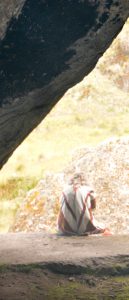
Eduardo is a treat. When the trail is wide enough, he likes to walk holding my hand. He speaks no English, nor do I speak Spanish, so we’re teaching each other a few words, but I fear he is the faster learner. We traded hats for a time, and though I love my hat dearly, I love his more!

So, back to the topic of the funeral. Washi’s mother, Marie, wanted him to go with her to the funeral of her best friend, but he told her he couldn’t because he was working (for me). Since I’m here to learn everything I can about this culture, I asked if it would be okay for me to attend.
Lunch took longer than we thought, and we ran out of time for me to go back to the hotel to change. People in the Sacred Valley, none of whom, I’m guessing, own anything in lycra, must now think that Americans have an interesting way of dressing for a funeral. Washi assured me that because my tights were black, I looked fine. Right. With my white hair and being one of the tallest people in the crowd (5’4″), who were, incidentally, all dressed in black, I wasn’t exactly camouflaged.
The funeral was held outside, next to the cemetery, which is apparently full. Instead of burying people in the ground, the deceased are now stacked about six coffins high, and cemented into long, low buildings that look like tiny condos — very strange and sad too, for a culture that so worships Mother Earth. The funeral itself was incredibly emotionally charged with a great deal of wailing and tearing of hair. Even grown men and teenaged boys were openly weeping. Everyone in the village was there – adults, kids – even the street dogs came. The family gathered around the coffin while everyone tossed flower petals, and the wailing of the grief-stricken became gut-wrenching as they slid the woman’s coffin into her allotted slot. One woman fainted and for a moment there was a mini stampede. Washi raced into the middle of the fray, scooped her up, and carried her to safety. I had been sitting on a wall next to a little boy with a tiny puppy, and the boy began to cry frantically. I picked him up so he could see that the woman who had fainted (his mother) was okay. After the excitement was over, an unending flow of Cusqueña beers changed the mood to one of a semi-subdued party atmosphere.
I’m feeling emotionally spent tonight. But I’m also feeling connected to The People of this beautiful place. I notice myself wondering about things like, how many funerals has the mountain overlooking the cemetery witnessed? And how does the Sacred River feel about having walls built on one side to keep it from flooding? I will take these wonderments with me now to my pillow.
DAY THREE ended with this — 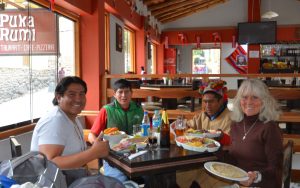
clearly not another funeral :-), though it could have been! This morning we are four: Washi; our driver, Miguel; Eduardo; and me. And we hiked two hours on a very rocky, very steep trail with a very sheer drop-off, to get to the top of a mountain. At one point, I slipped, and Miguel caught me by my backpack!! So, no funeral!
Notice the face in the rock?
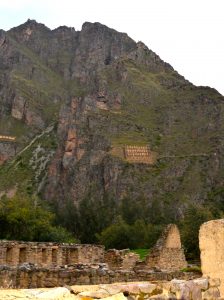 That’s Wiracocha, the son of the Sun.
That’s Wiracocha, the son of the Sun.
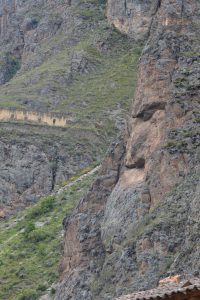
The three cardinal rules of the Inca — don’t lie, don’t steal, and don’t be lazy — are still honored to this day. However, they no longer throw rule-breakers from the top of Wiracocha’s head!
DAY FOUR – Today, I had the morning “off” so my day didn’t really start until noon, but when it did begin, it quickly blasted off into the stratosphere, which is where I feel like I still am. The entire afternoon and evening were spent interviewing Vidal Ayala Sinchez, Ollantaytambo’s master healer, wise man, village elder, and quite possibly the most amazing person I have ever met. I got to spend five hours with this man, asking questions for my book, for my life, and for the life of the planet.

As far as the book is concerned, let’s just say I have a ton of rewriting to do. This man gave me what I needed, which was the Inca perspective on the damage Pizarro and his men did to this country five hundred years ago and, according to Vidal (“Beedal”), the domino effect that damage continues to have on the rest of world – to this day. But let me back up.
I can’t say whether Washi or I got more out of today. Poor Washi was on his toes for hours, translating back and forth. Vidal is a true Teacher, asking almost as many questions of me as I did of him. He tested me over and over again until he was convinced that my intentions for my book are to speak The Truth. Vidal set me straight on so many details for my book, I can’t wait to do my rewrite!!!
THEN, we went to dinner where I had another 2-1/2 hours with Vidal. The conversation turned to topics like the Dalai Lama; sainthood; karma; how the image of the Southern Cross can be found from Patagonia to Alaska; and how, after 2,000 years, we still seem unable to follow the teachings of Jesus by treating one another with kindness, empathy, and respect.
DAY FIVE – It was an early wakeup this morning to get ready for my hike from Aguas Calientes to the stunning glory of the ancient city. It is my opinion that Machu Picchu must be earned. It’s meant to be a pilgrimage, and part of being there is getting there. Imagine a steady hour and a half on the StairMaster and you’ll be close.
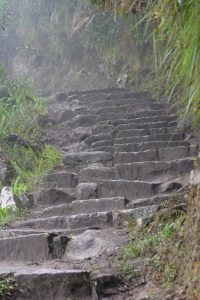
All along the way, Washi and I were treated to the sound of water — the swiftly moving Urumbamba River; countless springs; and the steady drip from last night’s rain. Begonias, orchids, and flowering bromeliads are scattered amongst the vines, mosses, and ferns, and you would swear you can actually see things growing. The air is cool and damp, and my hair is wild and crazy.
I’m coming back tomorrow, on my own, so I can just sit and be quiet and imagine what this place was like 500 years ago.
DAY SIX — I got another early start and was on the trail by 6:00 a.m. For the next hour and a half, it was as though I was the only one on the trail. I didn’t hear or see anyone until I reached the top, where my sense of peace was violently assaulted by crowds of people and buses and confusion. I quickly made my way up – more stairs! – all the way through Machu Picchu, to the trailhead that leads to Inti Punku, the Gate of the Sun. Once at the top, I was greeted with a stunning view of Machu Picchu and the mountains surrounding it.

I turned back and found a quiet place off the beaten track where I could see the entire sacred city. I pulled out my laptop – yes, I carried that AND my camera and three lenses – and read the first few chapters of The Serpent, The Puma, and The Condor. It was a trip, reading my novel in this place!! I inserted some descriptive paragraphs, and was back at my hotel by noon. Marathon-level exhausted, sweaty, and starving, I quickly showered, finished packing, and grabbed lunch before taking the train back to Ollantaytambo.
Washi met me at the train station, treated me to the world’s best ice cream, and then we attended a fire ceremony at Vidal’s. We burned sacred aromatic wood, chewed coca leaves, and heard stories of the Ancient People and how their lives, and the world, changed 500 years ago with the arrival of the Spaniards. We individually approached the fire and sent healing wishes to our loved ones at home, and voiced our intentions for becoming better versions of ourselves. Vidal and Washi sang songs in Quechua, and played the flute and drum. And all the while, Washi’s beautiful 3-year-old daughter, Ellen Rose, ran around, played, giggled, and handed out hugs, while his 11-year-old daughter, Victoria, helped Vidal with the fire. Afterwards, we drove to Cuzco, where, after checking into my new home for the next three nights, I fell asleep in the bathtub.
DAYS SEVEN, EIGHT, AND NINE – The rest of my time in Cuzco has been spent learning the difference between an Inca wall and a Spanish wall (the Incas had no need of mortar).
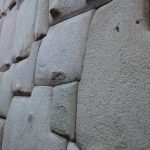

I watched women making dyes from indigenous plants while other women created beautiful weavings.
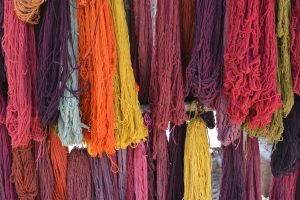
I spent time with an astronomer who showed me Jupiter and three of its four moons (the fourth was behind it) through a powerful telescope. The clouds parted just in time for us to also see beautiful Venus and the constellations of the southern hemisphere. The Ancient Incas recognized shapes in the Celestial River (the Milky Way) by focusing on the dark spaces outlined by the stars. And through the telescope, the crescent Moon looked to be so close, it startled me.
DAY TEN – Today, Washi and I flew to Cajamarca. We have two big days planned and I’ll try to give an update before heading into the Amazon Jungle. If this entry seems superficial and a bit traveloguey, I apologize. Much of what I’m experiencing is hard for me to contemplate, let alone put into words.
DAY ELEVEN – In case you don’t recognize the extremely happy caballera in this photo, it’s me — and yes, I have gone native. My horse is Gladiator, but don’t let his name fool you. He’s a sweetheart. He’s a Peruvian Paso Fino, a gaited horse, which means you can ride him at a trot without posting. His front legs kick out to the side in a silly way as he moves, and he takes tiny, mincing steps, but what a ride! He’s a rocking horse!! My riding companion is Guillermo, a teacher and historian who knows the time period in which I am interested, inside and out.

After our ride, we went in to the city of Cajamarca and visited the place where Atahualpa was held captive while the Spaniards collected his ransom — and where they killed him after they got what they wanted. This amazing painting depicts Atahualpa just after baptism was forced upon him and he was christened, “Juan de Atahualpa”. The two dark figures are Pizarro and the priest who demanded his death for the crime of heresy.
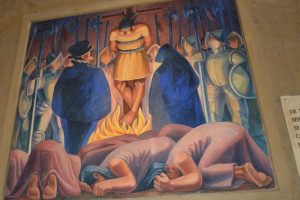
SEVERAL DAYS LATER – I’m now at Kapitari Lodge, an Ayahuasca lodge deep in the Amazon jungle. I had been curious about this plant medicine for a few years, but it had not occurred to me that it would play a part in my book until after the fourth and final ceremony. I won’t lie — the nausea and purging are VERY tough. The brew didn’t taste too bad the first night, but my fellow Kapitarians universally agree that every night, it became thicker and thicker, and nastier and nastier. As far as the facilities go, this is definitely a no frills kind of place — cold showers, no electricity after 7:00 pm, and small portions of salt-free meals.
But what made it doable was the support I received from Don Lucho, his staff, and the amazing people with whom I shared this experience. There were eighteen of us, and I’ll confess that at first, I was disappointed that there were so many. But within twenty-four hours, I would not have changed a thing. Apparently, Mother Ayahuasca knows just which people to bring together. My fellow travelers came from the U.S., Israel, Germany, Chile, France, the UK, Russia, India, and Canada — and from all walks of life: a welder, a nurse, a school teacher, two or three businessmen, a housewife, two psychologists, a master’s candidate in neurobiology, a journalist, and I forget what else. At sixty-five, I am the oldest, and the youngest is twenty-one — twelve men, six women. For English-speaking support, we had three assistants, and they did a perfect job of making everyone feel safe.
The ceremonies were rich. Don Lucho and his son, Wagner, sang Icaros throughout the ceremony, and the music both took me away and at the same time kept me grounded. Interestingly, experiences for all of us were pretty consistent on any given night, yet each night was different from the others — a beautiful thing!
And now, I’ve just got to sit with all this for a while. I had underestimated the power of this trip, thinking it was only the Kapitari Lodge at the end that would be challenging. But from Day One, I’ve undergone a serious spring cleaning of my psyche. I’m told Ayahuasca will stay with me for at least nine months and maybe forever. My “skinny” jeans are loose from the tiny, sugarless, saltless meals; the skipped dinners on the nights of the ceremonies; and the absolutely violent purging! But my mind is calm and my heart is open. And I have come away with the knowledge that my writing will take precedence over everything else because this is a book that needs to be written. I’m eager to take what I’ve learned and hopefully do my subject justice.
